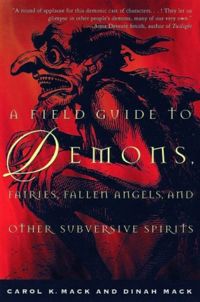On November 27th, 2022, the 8,000th article was added to the SuccuWiki!
A Field Guide to Demons
| A Field Guide to Demons, Fairies, Fallen Angels and Other Subversive Spirits | |
|---|---|
 A Field Guide to Demons, Fairies, Fallen Angels and Other Subversive Spirits Book Cover, written by Carol K. Mack and Dinah Mack | |
| Author(s) |
Carol K. Mack Dinah Mack |
| Publisher |
Henry Holt and Company LLC Arcade Publishing |
| Publication date | October 15, 1999 |
| Media type |
Hardcover Paperback eBook |
| Length | 336 Pages |
| ISBN | 978-0805062700 |
| ASIN | B005M26IWK |
For other uses of the word Succubus, see Succubus (disambiguation).
For other uses of the word Incubus, see Incubus (disambiguation).
A Field Guide to Demons, Fairies, Fallen Angels and Other Subversive Spirits is an encyclopedic book written by Carol K. Mack and Dinah Mack. In this work Succubi and Incubi are referenced.
Overview
- Title: A Field Guide to Demons, Fairies, Fallen Angels and Other Subversive Spirits
- Authors: Carol K. Mack and Dinah Mack
- Published By: Henry Holt and Company LLC & Arcade Publishing
- Length: 336 Pages
- Format: Hardcover, Paperback & eBook
- ASIN: B005M26IWK
- ISBN-10: 080506270X (Paperback)
- ISBN-13: 978-0805062700 (Paperback)
- Publishing Date: October 15, 1999
Plot Summary
The Macks divert our gaze from our contemporary red-faced, cloven-hoofed misrepresentation of demons to remind us of the ancient roles demons were originally assigned to play. From the Tommyknockers of North American mountain mines to the South African Mbulu that waits in the river for lone travelers, A Field Guide to Demons classifies these creatures by their domains--water, mountain, forest--rather than in alphabetical or cultural order, dishing out antique and contemporary lore on these most misunderstood of spirits. A Field Guide to Demons melds folklore and mythology; maintains a surprisingly evenhanded view of demons; and reveals their role as the necessary challenger to established order, the antagonist--without which there could be no hero--and the darkness through which goodness shines brightest. --Brian Patterson
Book Review
The following review can be found in the Amazon.com listing in the External Links below:
- 4 out of 5 stars
- A Fascinating, Frightening and Sometimes Amusing Look at Malicious Spirits Worldwide
- Reviewed On: May 26, 2006
- Reviewed By Zekeriyah
Well, as the title says, this book is a "field guide" to Demons, faeries and other malicious spirits. The book opens with a couple discussions on the nature of demons, evil, and so forth, before splitting into a field guide style approach that breaks it down into sections like "mountain", "ocean", "desert" and so forth. Within in each section are given several different demons or types of demon, along with a write up of their habits, myths and lore, how to defeat them and the like.
The first section, "Oceans", covers several well known sea monsters and water faeries such as mermaids, the Japanese kappa, the Australian bunyip, the Russian rusalka and the Scottish kelpie, amongst others (like the Mbulu, a water person from Zulu folklore). In the "Mountains" section we get a wide variety of demons, ranging from Huwawa (from the Epic of Gilgamesh) to the tiny Abatwa of Zulu belief and the "little people" of Cherokee folklore. The "Forest" chapter includes a number of wild monsters like the flesh-eating Windigo of Native American belief, Japanese fox-spirits and the Rakshasa of Hinduism. A section on "the Desert" covers things like the djinn and ghuls of Islamic belief, the Mimi of Australian Aboriginal lore and Set, the Egyptian god of darkness. "The Domicile" introduces spirits of the household and domestic spheres, like the Jewish Lilith, the Changing Bear Woman of the Navajo, and the Changelings of British folkelore. The last chapter, "The Psyche", introduces highly abstract demons that play with the concept of the self, like the werewolf, Mr. Hyde, the Id and the Jewish dybbuk.
None of the entries are overly long, nor is this book a comprehensive list of demons, but it does provide a wonderful glimpse at the countless devils, evil spirits and other things that have haunted mankind's beliefs for centuries. The authors never seem to commit themselves to any one stance on the existance of demons, for the record, and I've known very religious people who have read this book. Whether or not you believe in the spirits presented here, it is a fascinating cross-cultural study of malicious spirits. Particularly if you know very little about mythology, folklore and religion to begin with. Things like faeries, werewolves and mermaids may well be common place in our vocabulary, but lesser known myths like the Patupairehe, Isitwalangcengce, Eloko and the gruesome Nuckelavee are equally frightening. All in all, a well thought out and executed book.